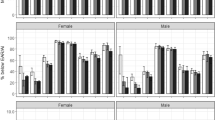Abstract
Objective
To document mineral contents iron, zinc, calcium, energy contents and nutrient densities in complementary foods commonly given to young urban slum children.
Methods
Information on dietary intake was collected from 892 mothers of children aged13-24 months, using 24 hour dietary recall and standardized measures. Three variations of 27 most commonly prepared recipes were analyzed and their energy (Kcal/g) and nutrient densities (mg/100Kcal) were calculated.
Results
Considerable variations were observed in preparation of all items fed to the children. Cereal-based items predominated their diets with only small amount of vegetables/fruits. Fenugreek was the only leafy vegetable included, but was given to only 1–2% of children. Iron, calcium, zinc contents of staple complementary foods ranged from: 0.33mg to 3.73 mg, 4mg to 64 mg, and 0.35mg to 2.99 mg/100 respectively. Recipes diluted with less water and containing vegetables, spices had higher mineral content. Minerals densities were higher for dals, fenugreek vegetable, khichdi and chapatti. Using the median amounts of the various recipes fed to children, intakes of all nutrients examined especially calcium and iron was low.
Conclusion
There is an urgent need to educate mothers about consistency, dilution, quantity, frequency, method of preparation, inclusion of micronutrient-rich foods, energy-dense complementary foods and gender equality.
Similar content being viewed by others
References
National Family Health Survey (NHFS-3), India (2005-2006), International Institute for Population Sciences, Mumbai, India.
World Health Organization. Infant and Young Nutrition Department of Nutrition, Health and Development 2002.
Bhandari N, Mazumder S, Bahl R, Martines J, Black RE and Bhan MK. An educational intervention to promote appropriate complementary feeding practices and physical growth in infants and young children in rural Haryana, India. J Nutr 2004; 134: 2342–2348.
Kapur D, Sharma S, Agarwal KN. Dietary intake and growth pattern of children 9-36 months of age in an urban slum in Delhi. Indian Pediatrics 2005; 42: 351–356.
Khokhar A, Singh S, Talwar R, Rasania SK, Badhan SR Mehra M. A study on malnutrition among children aged 6 months to 2 years from a resettlement colony of Delhi. Indian J Med Res 2003; 57: 286–289.
Laxmaiah A, Mallikharjuna KR, Brahmam G, Kumar S, Ravindranath M, Kashinath K et al. Diet and nutrition. Indian Pediatrics 2002; 39: 331–338.
Yadav RJ and Singh P. Nutritional status and dietary intake in tribal children of Bihar. Indian Pediatrics 1999; 36: 37–42.
Lane RH. Estimation of Iron, Calcium and Zinc. In Howritiz W, Robertson AH, Fisher HJ, Epps EA, Quacker bush FW, Reynolds H, ed. AOAC: Official Methods of The Analysis of The Association of The Official Agricultural Chemists, 17 th ed. MD, USA. International Gaithersburg, 2000: 2.
Gopalan C, Ramashastry B and Balasubramaniam S. Table of food composition. Nutritive value of Indian foods. National Institute of Nutrition. Indian Council of Medical Research. Hyderabad; Avon Printing works, India, 1999.
Kikafunda J, Walker A and Tumuine J. Weaning foods and practice in Central Uganda. African J Foods Agricult Nutrit Development 2003; 3: 7–12.
Ljungqvist B, Mellander O, Svanberg U. Dietary bulk as a limiting factor for nutrient intake in pre-school children. I: A problem description. J Trop Paediatr 1981; 27: 68–73.
Parker ME, Schroeder DG, Begin F, Hurtado E. Maternal preferences for the consistency of complementary foods in Guatemala. Food Nutr Bull 1998; 1: 23–34.
Brown K, Grinar M, Perez F, Pierson J, Gahoja L, Stren S. Effects of dietary energy density and feeding frequency on total daily energy intakes by recovering malnourished children. Am J Clin Nutr 1995; 62: 13–18.
WHO/UNICEF. Complementary feeding of young children in developing countries: a review of current scientific knowledge. Department of Nutrition Health and Development 1998; 98: 1–4
Onofiok NO, Nnanyelugo DO. Weaning foods in West Africa: Nutritional problems and possible solutions. Food Nutr Bull 1998; 1: 23–35.
Dewey KG, Brown KH. Update on technical complementary feeding of young children in developing countries and implication for intervention programs. Food Nutr Bull 2003; 24: 5–28.
Treche S, Mbome IL. Viscosity, energy density and osmolality of gruels for infants prepared from locally produced commercial flames in some developing countries. Internat J Food Science Nutrit 1999; 50: 117–125.
Whitehead RG. Infant feeding practices and the development of malnutrition in rural Gambia. Food Nutr Bull 1979; 1: 1–5.
Author information
Authors and Affiliations
Corresponding author
Rights and permissions
About this article
Cite this article
Jani, R., Udipi, S. & Ghugre, P. Mineral content of complementary foods. Indian J Pediatr 76, 37–44 (2009). https://doi.org/10.1007/s12098-009-0027-z
Received:
Accepted:
Published:
Issue Date:
DOI: https://doi.org/10.1007/s12098-009-0027-z



